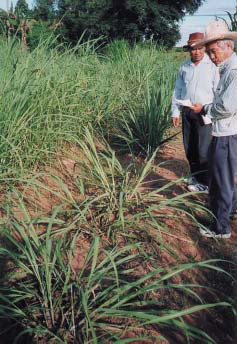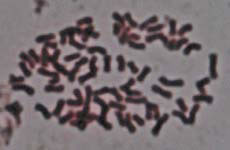Development of high biomass forage crops tolerant to water stress by interspecific and intergeneric crossing
Description
[Objectives]
The lack of sufficient feed resources during the dry season has substantially limited ruminant production in Northeast Thailand. Forage crops of high yield and nutritive value must be produced in order to address these problems. It has been reported that some interspecific and intergeneric hybrids of Saccharum complex have shown good ratooning ability, as well as markedly vigorous growth and high yield. It is expected that new, highly adaptable forage crops can be bred in Northeast Thailand using such hybrids and a series of new criteria selection processes. The purpose of this study was to screen breeding materials for high biomass and adaptability to the environmental conditions of Northeast Thailand, and then to breed new types of forage crops using interspecific and intergeneric hybridization among sugarcane and their wild relatives. This project has been conducted in collaboration with the Khon Kaen Field Crops Research Center (KKFCRC).
[Results]
In 2002, researchers evaluated the wild relatives of sugarcane collected in Thailand (Fig. 1) and characterized some of these as breeding materials using cytological analysis (Fig. 2). In addition, researchers modified methods for crossing and pollen cryopreservation. As a result, about 3,000 seedlings were obtained from the 16 combinations of cross between commercial sugarcane and selected S. spontaneum. The evaluation of these progenies is in progress in the field. In addition, to evaluate the productivity of these breeding lines as a forage crop, field experiment to compare the harvest interval and re-growth rate after harvest are also being investigated. The stem and leaves of these breeding lines will be accessed nutrient value, silage adoptability, etc. by animal husbandry group.
Figure, table
-
Fig. 1. Sugarcane germplasm conservation field at the KKFCRC. Researchers are shown evaluating and characterizing the wild relatives of sugarcane. -
Fig. 2. Metaphase chromosome spread on root tips of accession 98T-1 (2n=70).
- Affiliation
-
Japan International Research Center for Agricultural Sciences Okinawa Subtropical Station
- Classification
-
Technical A
- Term of research
-
FY2002 (FY2001-2005)
- Responsible researcher
-
MATSUOKA Makoto ( Agriculture, Forestry and Fisheries Research Council Secretariat, Ministry of Agriculture, Forestry and Fisheries )
ARIFIN Noor Sugiharto ( JIRCAS Visiting Research Fellowship Program )
TERAUCHI Takayoshi ( Okinawa Subtropical Station )
TAMURA Yasuaki ( Okinawa Subtropical Station )
TANIO Masahiko ( Okinawa Subtropical Station )
- ほか
- Publication, etc.
-
S. Fukuhara, W. Ponragdee, M. Matsuoka, A. Sugimoto, T. Sansayawichai, Y. Terajima and K. Ujihara (2003): Studies in Saccharum spontaneum in Thailand – Preliminary studies in chromosome number. Japanese Journal of Tropical Agriculture, 47 (Extra issue 2), 103–104.
- Japanese PDF
-
2002_25_A3_ja.pdf910 KB
- English PDF
-
2002_25_A4_en.pdf69.97 KB


